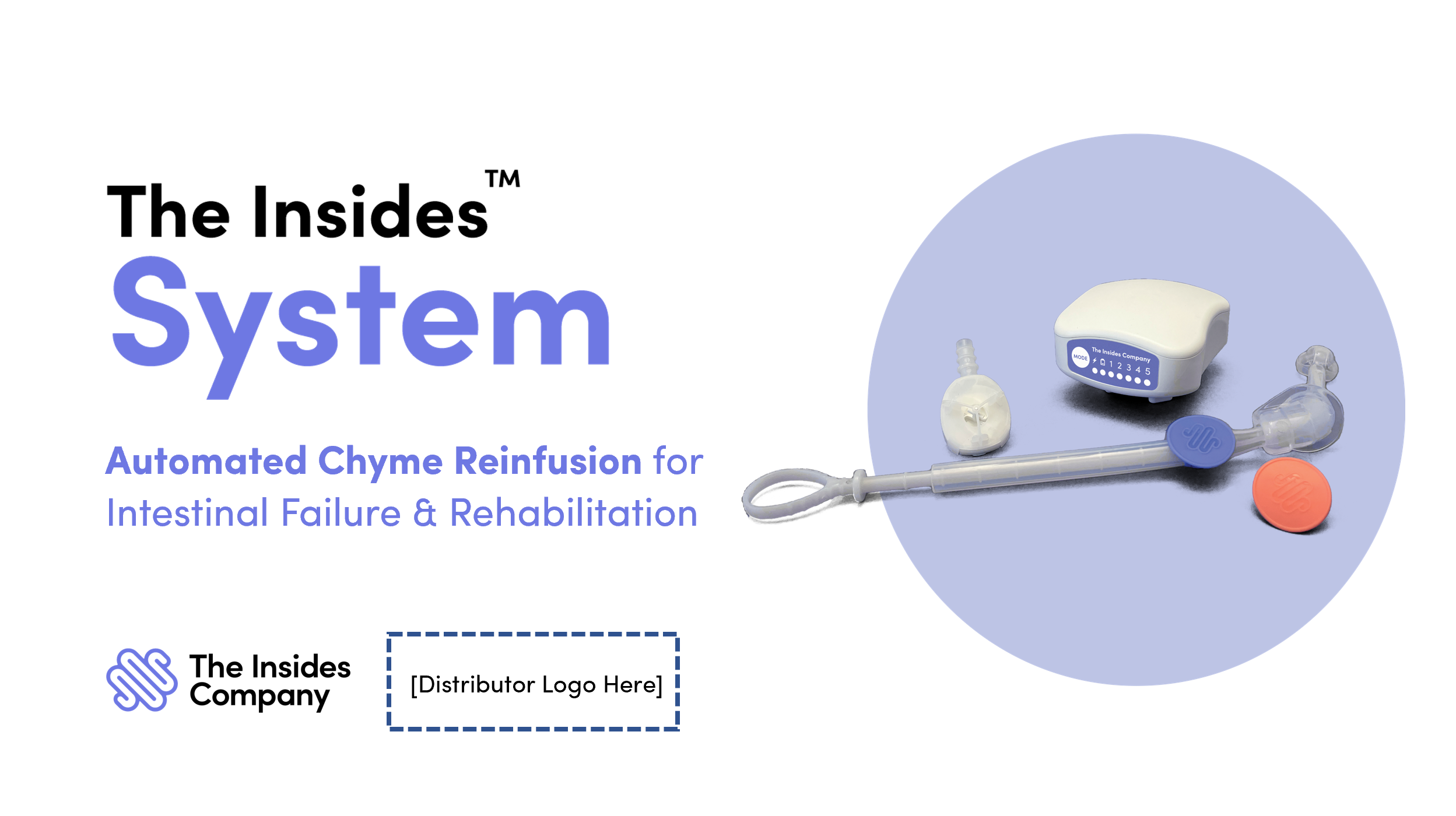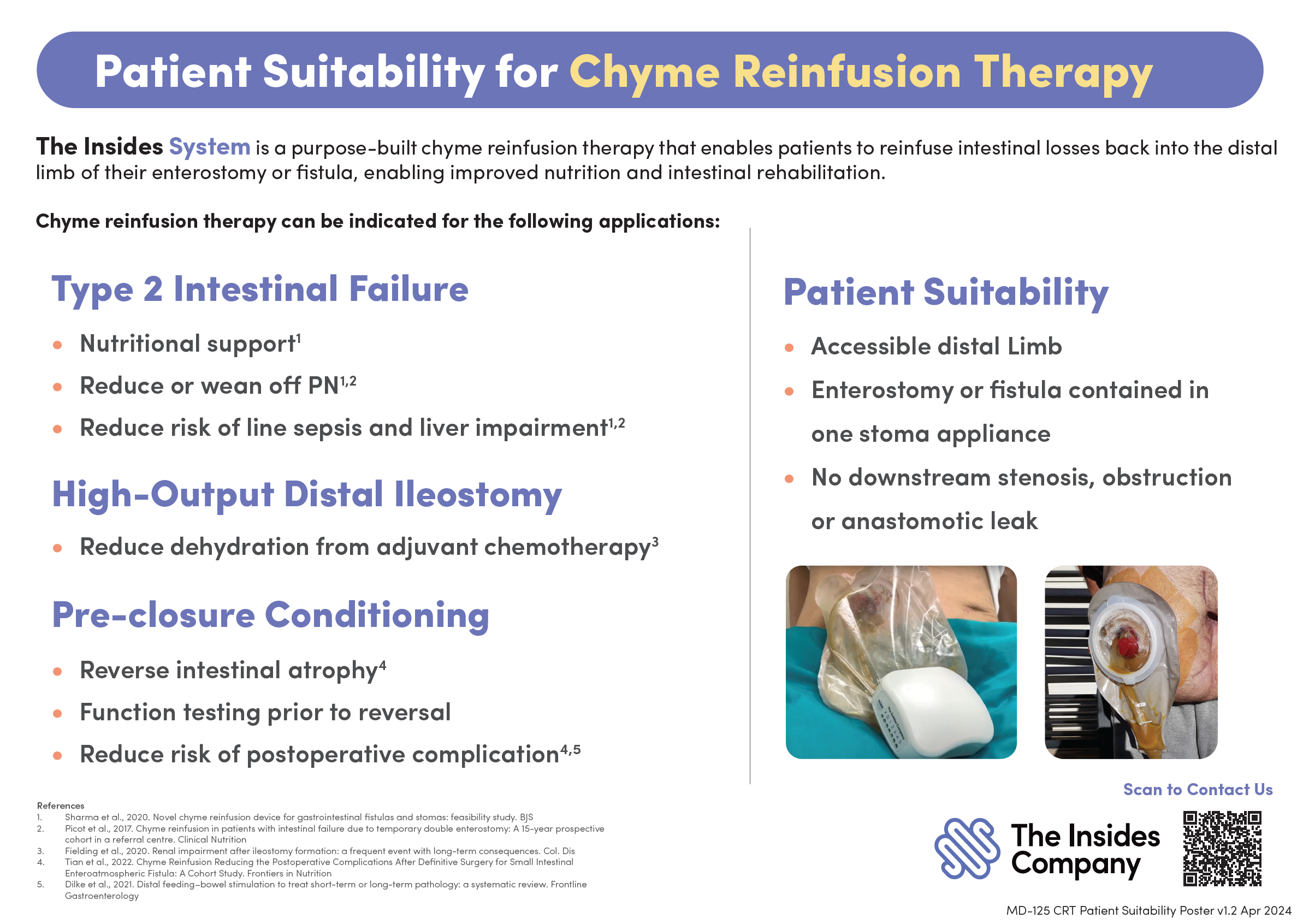Click here to download the PDF
1. Purpose
This document provides guidance for healthcare professionals managing situations where The Insides Tube has migrated into the distal intestine. It is intended to support safe and effective clinical decision-making, helping to minimise the risk of patient harm. The information contained here should be used as supplementary material alongside the clinical judgment and expertise of the treating healthcare team.
2. Scope
This document applies to specialised colorectal and/or gastroenterology multidisciplinary teams that manage patients who are performing chyme reinfusion therapy with The Insides System. This includes Colorectal surgeons, Gastroenterologists, Stomal therapy nurses who have been trained to install The Insides System, troubleshoot, and support patients’ day to day with using the device.
There is a low risk that The Insides Tube may migrate into the intestine, generally due to peristalsis. This document will provide a trained healthcare professional with guidance on the safe and effective management of such occurrences, including the process to safely remove The Insides Tube.
3. Definitions
Tube Migration - If The Insides Tube migrates into the distal intestine, it either gets completely drawn in or it partially drawn in with The Insides Pump stopping it from being drawn in any further.
Common terms:
• Tube or catheter ingress
• Tube or catheter displacement
• Tube or catheter pushed in
• Tube or catheter sucked in
• Tube or catheter migration
• Tube or catheter completely disappears
Tube - The Insides Tube
Pump - The Insides Pump
4. Responsibilities
It is the responsibility of the healthcare professional managing the day-to-day care of the patient to provide all the training to the patient, so they are able to manage and troubleshoot the device themselves. During this initial training period, the patient should be supplied with the contact numbers of their healthcare team, so they know who to call in an emergency.
5. Identification and Clinical Management Steps
Note: If a patient is at home in the community, the patient must be reviewed face to face by their healthcare professional; do not let the patient attempt the removal of the Tube themselves.
The following procedure should be completed by a trained health care professional and we suggest having a second healthcare professional assisting:
1. Ensure the patient is comfortable
2. Stop the tube from migrating further into the intestine by securing with metal forceps, or other suitable means. If the Pump is the only accessible component, this can be secured, however do not pull on it.
3. Administration of antispasmodic medication is recommended. Be aware of the medication’s onset of action.
4. If the Pump is accessible and is still attached to the Tube, DO NOT REMOVE IT from the Tube.
5. If the Tube is still visible:
a) Suggest use of metal forceps so a firm grip of the Tube can be achieved.
b) Place the forceps around the Tube and pull slowly and consistently. This may take several minutes.
i. Ensure the retention sleeve comes with the Tube. This is where the second healthcare professional may be necessary to manipulate/guide the retention sleeve through the fascial opening either digitally or with a second set of metal forceps
ii. If the Tube feels like it is suctioned in place, fill a ‘catheter tip syringe’ with potable water or saline and administer this down the tube so that it can trickle out of the bulbous end and release the suction.
c) Once out, discard this Tube and replace with a new tube so the patient can continue chyme reinfusion. Prior to inserting a tube, evaluate the patients facial opening to ensure that the tube will not migrate into the intestine. A radiological study may need to be performed to ensure that there is no damage to the intestine. Follow the instructions for Tube insertion in The Insides System Setup Guide for Healthcare Professionals. A video of a Tube insertion is available on the Training Hub (www.theinsides.co/training-hub/home)
d) Take this opportunity to refresh information to the patient about being mindful of vigorous exercise and any abdominal-centric movements such as bending over for long periods of time
e) Once the intervention is complete, report the incident to your local distributor of The Insides System and/or The Insides Company
6. If the Tube is not visible:
a. Radiographic imaging can be used to locate the Tube, Retention Sleeve and Pump
b. Endoscopic removal can be the safest option depending on the location of the Tube
i. ENSURE the Retention Sleeve is removed at the same time as the Tube is removed
c. Once out, discard the Tube
i. If the Tube removal was difficult or there is evidence of bowel injury, we recommend re-imaging the distal bowel with contrast before recommencing chyme reinfusion therapy.
ii. If the Tube removal was routine with no abnormalities seen during the endoscopic intervention, replace with a new Tube so the patient can continue chyme reinfusion. Follow the instructions for Tube insertion in The Insides System Setup Guide for Healthcare Professionals. A video of a Tube insertion is available on the Training Hub (www.theinsides.co/training-hub/home)
d. Take this opportunity to refresh information to the patient about being mindful of vigorous exercise and any abdominal-centric movements such as bending over for long periods of time
e. Once the intervention is complete, report the incident to your local distributor of The Insides System and/or The Insides Company
6. Training and Education
• The Insides Company Clinical team are available for refresher training, complex patient management discussions, and technical support. Please contact them on clinical@theinsides.co or support@theinsides.co
• The Insides Company Training Hub contains up-to-date information, documents for download, and training videos. www.theinsides.co./training-hub/home
Distributor News Feed, March 2025, The Insides System
Distributor News Feed, March 2025, The Insides System and The Insides Neo
Distributor News Feed, April 2025
Distributor News Feed, June 2025
Distributor News Feed, July 2025
Distributor News Feed, August 2025
Distributor News Feed, September 2025
Distributor News Feed, October 2025
Chyme Reinfusion Publications - The Insides System
Stoma-Output Reinfusion Device for Ileostomy Patients:A Feasibility Study - Download
Novel chyme reinfusion device for gastrointestinal fistulas and stomas:feasibility study - Download
Chyme Reinfusion Publications - 3rd Party
https://doi.org/10.1002/ncp.10417
https://doi.org/10.1002/ncp.10823
A review of chyme reinfusion: new tech solutions for age old problems - Download
https://doi.org/10.1080/03036758.2022.2117832
Management of entero-atmospheric fistulas by chyme reinfusion: A retrospective study - Download
https://doi.org/10.1016/j.clnu.2020.03.030
http://dx.doi.org/10.1136/flgastro-2019-101359
Refeeding enteroclysis as an alternative to parenteral nutrition for enteric fistula - Download

Please work with your local Insides Co. sales manager to complete this sales presentation for your territory
Please distribute this document to any customers/KOLs to grow our understanding of the healthcare pathway for managing intestinal failure patients in your region
Please contact us if you would like to download the poster with dedicated distributor logo. (in your language)
